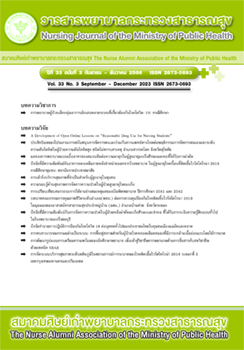Effectiveness of a Telehealth Self-management Support Program on Self-management Behavior and Blood Pressure among Essential Hypertension Patients in Sawankhalok District, Sukhothai Province
Main Article Content
Abstract
A two-group quasi-experimental pretest-posttest design was used to investigate the effectiveness of a telehealth self-management support program on self-management behavior and blood pressure among essential hypertension patients. The sample consisted of 70 patients who were serviced at the non-communicable disease clinic in Sawankhalok District, Sukhothai Province. These patients were sampled by purposive sampling based on inclusion criteria. The sample was divided into 2 groups: 35 patients were assigned to the experimental group and received the telehealth self-management support program over a period of 12 weeks, which was developed based on the concept of self-management by Creer. The comparison group consisted of 35 patients who received routine care. Data were collected using the hypertension self-management questionnaire and non-invasive mechanical sphygmomanometers with digital display, before and after the experiment. Data were analyzed with descriptive statistics, Chi-square test, Fisher’s exact test, independent t-test, and paired sample t-test. The study revealed that after the intervention, the experimental group had a mean score for self-management behavior that was significantly higher than before intervention group and also higher than the comparison group (p<.001). In addition, it was found that the mean diastolic and systolic blood pressure after the intervention were significantly lower in the experimental group than before the intervention and lower than in the comparison group. (p<.001). The results suggest that telehealth self-management support program was effective in improving self-management behavior and blood pressure control among patients with essential hypertension.
Article Details

This work is licensed under a Creative Commons Attribution-NonCommercial-NoDerivatives 4.0 International License.
บทความและรายงานวิจัยในวารสารพยาบาลกระทรวงสาธารณสุข เป็นความคิดเห็นของ ผู้เขียน มิใช่ของคณะผู้จัดทำ และมิใช่ความรับผิดชอบของสมาคมศิษย์เก่าพยาบาลกระทรวงสาธารณสุข ซึ่งสามารถนำไปอ้างอิงได้
References
NCD Risk Factor Collaboration (NCD-RisC). Worldwide trends in hypertension prevalence and progress in treatment and control from 1990 to 2019: a pooled analysis of 1201 populationrepresentative studies with 104 million participants Lancet (London, England) 2021;398(10304): 957-980. doi:10.1016/ S0140-6736(21)01330-1.
World Health Organization. Hypertension [internet]. 2021 [cited 10 August 2021]. Available from: https://www.who.int/news-room/fact-sheets/detail/hypertension
Kotchen TA. Harrison’s principles of internal medicine: hypertensive vascular disease. New York: McGraw-Hill; 2015.
Health Data Center. Prevalence hypertension [internet]. 2021 [cited 11 August 2021]. Available from:
https://sti.hdc.moph.go.th/hdc/main/index.php
Sawankhalok Hospital. CPG COVID-19 2021. Sukhothai: Sawankhalok hospital; 2021.(in Thai)
Guo Y, Albright D. The effectiveness of telehealth on self-management for older adults with a chronic condition: a comprehensive narrative review of the literature. Journal of telemedicine and telecare 2018;24(6):392–403. doi: 10.1177/ 1357633X17706285.
Karoonngamphan M, Suvaree S. Reducing the risk of hypertension: the important role of nurses in empowering clients. Songklanagarind Journal of Nursing 2016;36(3):222-33.(in Thai).
Desta M, Yibelltal D, Memiah P, Ayenew T, Mulugeta H, Gedefaw M, et al. Antihypertensive medications adherence and associated uncontrolled blood pressure among hypertensive patients in Ethiopia: systematic review and meta-analysis. International Journal of Africa Nursing Sciences 2022;16:1-12. doi: 10.1016/j.ijans.2022.100404.
Lorig KR, Holman H. Self-management Education: History, definition, outcome, and mechanisms. Annals of Behavioral Medicine: a publication of the Society of Behavioral Medicine 2003;26(1): 1-7. doi: 10.1207/S15324796ABM2601_01.
Creer TL. Promoting adherence to medical treatment in chronic childhood illness: concepts methods and interventions: self-management and the control of chronic pediatric illness. NewJercy: Erlbaum; 2000.
Srivanichakorn S, Sangwatanaroj S, Jiraporncharoen W, Trakulwong P, Quansri O. Self management support for NCDs: Thai style. Nonthaburi: Center of policy and strategy development for NCDs prevention and control, Ministry of public health; 2017.(in Thai)
Sanlah N. The effect of a self-management program on blood pressure control behavior of hypertensive patients. Journal of Nursing and Public Health Research 2021;1(1):27-39.(in Thai)
Wankham C, Wattana C, Khampalikit S. The effects of a self-management program on hypertension-controlling behaviors, and mean arterial pressure among persons with hypertension. Journal of Nursing 2015;42(1):49-60.(in Thai)
Aungsuroch Y, Polsook R, Anuruang S, Phongphibool S, Gunawan J, Nazliansyah. How a selfmanagement
program affects blood pressure among indonesians with hypertension. Iran J Nurs Midwifery Res 2022;27(3):229-35. doi: 10.4103/ijnmr.IJNMR_244_20.
Busayarasamee B. Development of care model for diabetes or hypertensive patients in the new era, Ampur Mueang, Nakhon Pathom. Region 4-5 Medical Journal 2023;42(1):63-77.(in Thai)
Tucker KL, Sheppard JP, Stevens R, Bosworth HB, Bove A, Bray EP, et al. Self-monitoring of blood pressure in hypertension: a systematic review and individual patient data meta-analysis. PLoS Medicine 2017;14(9):e1002389. doi: 10.1371/journal.pmed.1002389.
Lu JF, Chen CM, Hsu CY. Effect of home telehealth care on blood pressure control: a public healthcare centre model. Journal of Telemedicine and Telecare 2019;25(1):35–45. doi: 10.1177/1357633X17734258.
Sareepon K, Surit P. Effects of self-management on health behaviors and blood pressure among essential
hypertension patients. Journal of Nursing and Health Care 2015;33(3):110-16.(in Thai)
Chansree N, Nateetanasombat K, Kasiphol T. The effects of self-management program among uncontrolled hypertensive patients. Journal of Huachiew Chalermprakiet Science and Technology Journal 2020;6(1):58-68.(in Thai)
Wang JG, Li Y, Chia YC, Cheng HM, Minh HV, Siddique S, et al. Telemedicine in the management of hypertension: evolving technological platforms for blood pressure telemonitoring. Journal of clinical hypertension (Greenwich, Conn.) 2021;23(3):435–39. doi: 10.1111/jch.14194.
Gong K, Yan YL, Li Y, Du J, Wang J, Han Y, et al. Mobile health applications for the management of primary hypertension. Medicine (Baltimore) 2020;99(16):e19715. doi: 10.1097/MD.0000000000019715.
Hammersley V, Parker R, Paterson M, Hanley J, Pinnock H , Padfield P , et al. Telemonitoring at scale for hypertension in primary care: an implementation study. PLoS Medicine 2020;17(6):1-19. doi:10.1371/journal.pmed.1003124.

